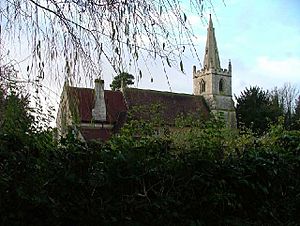St Helen's Church, Grove facts for kids
Quick facts for kids St. Helen's Church, Grove |
|
|---|---|
 |
|
| Denomination | Church of England |
| Churchmanship | Broad Church |
| History | |
| Dedication | St. Helen |
| Specifications | |
| Bells | 4 |
| Administration | |
| Parish | Grove |
| Deanery | Bassetlaw & Bawtry |
| Diocese | Southwell and Nottingham |
| Province | York |
St. Helen's Church, Grove is a special old church in Grove, Nottinghamshire. It's part of the Church of England. This church is so important that it's officially listed as a Grade II listed building. This means it has a lot of history and beautiful design.
Contents
The History of St. Helen's Church
The church building you see today was mostly designed by C. Hodgson Fowler in 1882. However, the church's history goes back much further, to medieval times.
How Old is the Church?
No one knows the exact year St. Helen's Church was first built. It was likely built before the Norman Conquest in 1066. The Domesday Book, a famous survey from 1086, mentions that there was a priest and a church here. It also noted that the land included 8 acres of meadow and a large area of woodland. Back then, the church and land were worth 40 shillings a year.
Changes Over Time
Long ago, this church had a complicated setup. It was like two rectories and a vicarage all at once. But in 1227, Walter de Grey, who was the Archbishop of York, decided to combine them. This made things simpler for the church.
In 1425, a knight named Sir Thomas Hercy left his best horse to the church's rector in his will. Later, Humphrey Hercy, Esq., asked to be buried in the church's chancel (the area near the altar).
The Church's Location and Design
St. Helen's Church is in a lovely spot, sitting on a small hill surrounded by old trees. It's a peaceful place. The church itself is small and very old. It is named after St. Helen.
The church has a main area called a nave and a chancel. From the outside, it looks simple. Inside, it is clean and well-kept. The tower is short and holds two bells.
Important Memorials and Tombs
Inside the church, especially in the chancel, you can find some interesting old stone slabs on the floor. These are memorials to people who lived long ago.
Ancient Floor Stones
One of these stones has a fancy cross carved on it, but the rest of the writing is too faded to read. Next to it is another stone for Hugo de Hercy. This stone is made of alabaster, which is a soft, white stone. It's about six and a half feet long and three feet wide.
On this stone, you can see carvings of a man in armor and a woman. The man has a hat and feather, and a dog at his feet. His face is worn away. The woman's face and hairstyle are also hard to see. There's a crack across the stone, so it's hard to tell what was at her feet. Above the man's head is a shield, but its colors are gone. Above the woman's head, there's a special cross shape.
Near the edge of the stone, there's a Latin inscription that says: "Here lies Hugo Hercy, who died on the 6th day of December in the year of our Lord 1405, and Elizabeth his wife, who died in the year of our Lord 1401. May God be merciful to their souls."
Other Notable Memorials
In the aisle (the walkway in the church), there's another stone with the word "Resvrgam" (which means "I shall rise again") and the name Katharine Neville, who died on May 17, 1683.
In the chancel, there's also a neat monument on the wall. It remembers WILLIAM LEVINZ, Esq. He was the only son of Sir Creswell Levinz, who was a judge. William Levinz was a Member of Parliament for many years, representing East Retford and then this county. He was known for his skill, hard work, and honesty. He passed away on May 7, 1747, at 76 years old. His wife, Anne, died on June 15, 1726, and is also buried there.
The church's income, called a rectory, was valued at £10 when the Hercy family were patrons. Today, it's valued at £11. 14s. 2d. in official records.
How the Parish is Organized
St. Helen's Church is part of a group of churches in the area. This group includes:
- St. Nicholas' Church, Askham
- St. Helen's Church, Grove
- Church of St. John the Baptist, East Markham
- St. Peter's Church, Headon-cum-Upton
The Church Organ
The church has a pipe organ that was made by Bevington in 1859. It was brought to St. Helen's Church in 1894. You can find more details about this organ on the National Pipe Organ Register.
See also
- Listed buildings in Grove, Nottinghamshire

